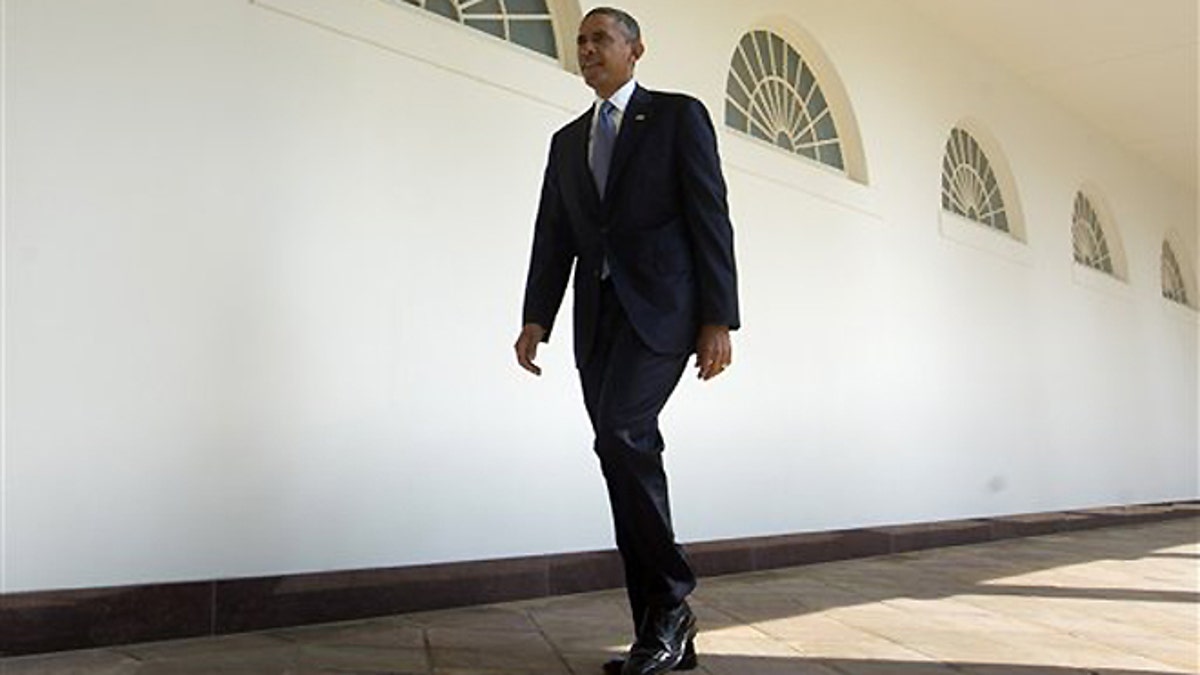
Sept. 10, 2013: President Obama walks along the West Wing Colonnade toward the Oval Office of the White House in Washington, ahead of his daily briefing. (AP Photo/Pablo Martinez Monsivais)
Editor's note: The White House initially announced that President Obama would speak from the Oval Office in an address to the nation on the Syria crisis on September 10. On Tuesday evening, the address was delivered instead from the East Room of the White House.
When President Obama addresses the nation Tuesday night, he will do so from the Oval Office, the most symbolic room in the White House.
By speaking from the Oval, he will signal the American people that “this is my most important message for America right now. This message is for you.”
Over the years many presidents have tapped the emblematic power of the oval when they have something supremely important to convey. Why does the Oval Office carry such significance? It starts with the shape. Ovals suggest equality and representation.
[pullquote]
Take George Washington. When he served as our first president, he lived in a house in Philadelphia.
He ordered the construction of bow-shaped ends to the room where he received guests. He stood in the middle and his guests surrounded him. By encircling him, no one person was closer to the president than anyone else.
This was a contrast to a monarchy.
Unlike a rectangle-shaped room, the oval shape created an equal playing field, a very republican—and democratic—idea. Oval-shaped tables in business settings carry the same symbolism.
In the 1790s Washington envisioned plans for the soon-to-be built President’s House to include an oval-shaped room.
Today that house is called the White House and that room is called the Blue Room, which is in the center of the state or main floor.
In 1909 President William Howard Taft tapped the power of the oval once again. He ordered the construction of a new office, the Oval Office, in the newly built West Wing adjacent to the White House.
In this way he showed that he was the center of the Executive Branch of government. He did this literally, too, by asking that all executive agencies send their budgets to him first before giving them to Congress.
Fast forward to the television era. For the first time Americans could see their president in the Oval Office.
They could see the logic behind President Kennedy’s call for tax reductions through the charts he had erected in the Oval Office for his speech.
They could see the tension in Jimmy Carter’s body language as he pounded the Oval Office desk more than thirty times to show his angst over the country’s decline during his “malaise” or Crisis of Confidence speech.
They could hear the tenderness in Ronald Reagan’s voice as he spoke about the tragedy of the space shuttle Challenger’s explosion.
They could detect the sadness in George W. Bush’s eyes when he spoke from the Oval Office the night of the terrorists attacks of Sept. 11, 2001.
As symbolic as it is, the Oval has one draw back. Because presidents do not have a live audience with them when they speak from the Oval Office, they don’t enjoy the same energetic feedback that they receive from a large crowd at a campaign rally.
They can’t see the response on people’s faces or get revved up from boisterous applause. They are literally talking into a silent camera. As a result, sometimes they come across stiff in an Oval Office address.
Reagan, a former professional actor, was the best at overcoming this challenge. That’s one reason he chose to speak from the Oval Office more than two dozen times, the most of any modern president.
Regardless, the power of the Oval can overcome the stiffness of a monologue. When presidents choose the Oval as their backdrop, they send a symbolic message that says: “this talk is for you.” It’s as if they’ve invited each American to stand in a circle around them and listen to the most important thing they have to say about the greatest issue facing the nation at the time.
In this century, the president saturates the lives of Americans 24/7 through social media and a never-ending news cycle. President Obama has only spoken two previous times from the Oval Office. By rarely using it as a setting, he heightens the importance of his message when he does use it.
Only time will tell if Obama’s speech Tuesday night about attacking Syria is successful. A recent Gallup poll shows that only 36% of Americans support U.S. intervention in Syria.
He needs enough people to surround him in support for his plan for the crisis in Syria.
He needs the power of the people to pressure Congress to support his plan.
He needs the power of the Oval.
Only time will tell if he is successful.
